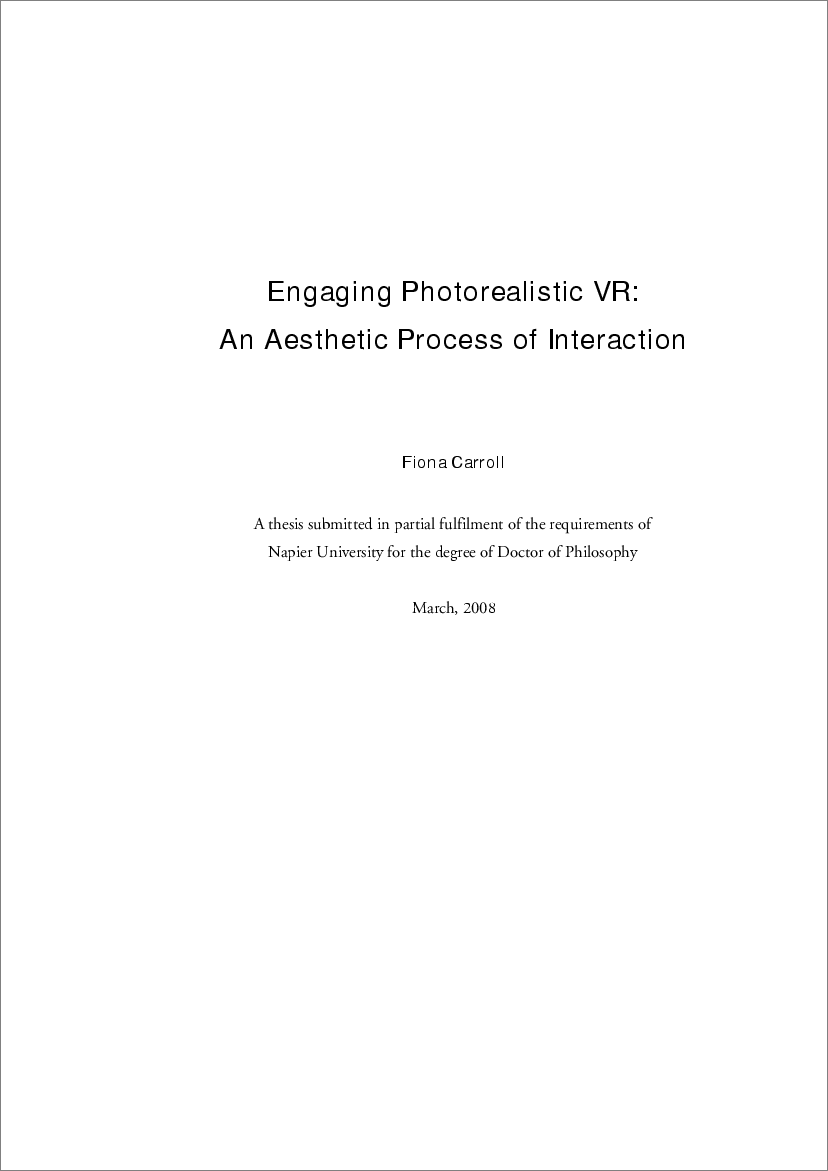Fiona Carroll
Engaging photorealistic VR: An aesthetic process of interaction.
Carroll, Fiona
Authors
Abstract
This thesis investigates the potential of aesthetics in the design of Human-Computer Interactions (HCI). In particular, it aims to provide a means by which aesthetics can be applied in photorealistic virtual reality (VR) to create ‘engaging’ experiences. Indeed, the author of this thesis suggests that much can be gained from looking at the aesthetics of photorealistic VR content as opposed to the more traditional HCI approaches that have primarily focused on the performance and efficiency issues of the technology. The thesis is motivated by the very notion that the aesthetic potential of photorealistic VR content is, and continues to be, underestimated whilst the emphasis
on the development of newer and more efficient visualisation technologies to create engaging VR
experiences increases. Challenging this, the research is firmly based on the premise that the aesthetic content of photorealistic VR environments holds at least as many possibilities for the creation of more complete and ‘engaging’ experiences.
To explore this, the thesis describes the aesthetic-interaction as a new type of interaction that focuses primarily on how one aesthetically interacts with an interface (as opposed to how one cognitively interacts with interface metaphors to activate certain aspects of its functionality). By concentrating on the design and the aesthetic content of photorealistic VR, more so than the
building and enhancing of its functional capabilities, the research aims to probe how the user might be sensually attracted and aroused into the sharing of information and hence the creation of new and ‘engaging’ experiences. In particular, this thesis examines the role of narrative in VR and from this, moves to the visual-narrative which for centuries has employed the use of aesthetics to ‘engage’
the spectator in its process of storytelling. Integrating traits of the VR medium and the visualnarrative, the author develops a visual-narrative structure which is used to elicit a number of design requirements specifically for photorealistic VR. From this, a visual-narrative model is developed, and in a second study, it is demonstrated that the photorealistic VR environments designed with the visual-narrative model can, indeed, create more ‘engaging’ experiences.
In summary, this research provides a means by which the aesthetics of photorealistic VR (or other HCI technologies) might be strategically patterned and applied to the creation of various different types of ‘engaging’ experiences. By describing the aesthetic-interaction and how it can be articulated through a visual-narrative model, the research not only successfully highlights the
experiential side of photorealistic VR, but also advances the new ‘design’ drive of HCI.
Citation
Carroll, F. Engaging photorealistic VR: An aesthetic process of interaction. (Thesis). Napier University. http://researchrepository.napier.ac.uk/id/eprint/2393
| Thesis Type | Thesis |
|---|---|
| Deposit Date | Jul 9, 2008 |
| Peer Reviewed | Not Peer Reviewed |
| Keywords | Human-computer interaction; HCI; Photorealistic virtual reality; Virtual reality; Aesthetics; Aesthetic-interation; Sensual-attraction; Engagement; Visual narrative; Design requirements; |
| Public URL | http://researchrepository.napier.ac.uk/id/eprint/2393 |
| Contract Date | Jul 9, 2008 |
| Award Date | 2008-03 |
Files
100dpi.png
(17 Kb)
Image
fcarrollthesis.pdf
(2.4 Mb)
PDF
Downloadable Citations
About Edinburgh Napier Research Repository
Administrator e-mail: repository@napier.ac.uk
This application uses the following open-source libraries:
SheetJS Community Edition
Apache License Version 2.0 (http://www.apache.org/licenses/)
PDF.js
Apache License Version 2.0 (http://www.apache.org/licenses/)
Font Awesome
SIL OFL 1.1 (http://scripts.sil.org/OFL)
MIT License (http://opensource.org/licenses/mit-license.html)
CC BY 3.0 ( http://creativecommons.org/licenses/by/3.0/)
Powered by Worktribe © 2025
Advanced Search

